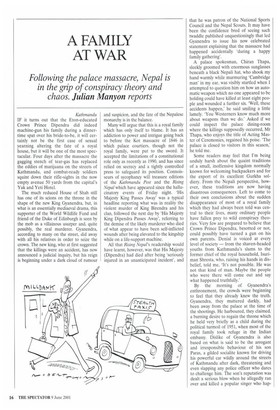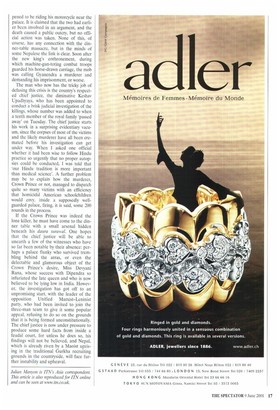A FAMILY AT WAR
Following the palace massacre, Nepal is in the grip of conspiracy theory and
chaos. Julian Manyon reports Kathmandu IF it turns out that the Eton-educated Crown Prince Dipendra did indeed machine-gun his family during a dinnertime spat over his bride-to-be, it will certainly not be the first case of sexual yearning altering the fate of a royal house, but it will be one of the most spectacular. Four days after the massacre the gagging stench of tear-gas has replaced the eddies of marijuana on the streets of Kathmandu, and combat-ready soldiers squint down their rifle-sights in the now empty avenue 50 yards from the capital's Yak and Yeti Hotel.
The much reduced House of Shah still has one of its scions on the throne in the shape of the new King Gyanendra, but, in what is an essentially mediaeval drama, this supporter of the World Wildlife Fund and friend of the Duke of Edinburgh is seen by the mob as a villainous usurper and, quite possibly, the real murderer. Gyanendra, according to many on the street, did away with all his relatives in order to seize the crown. The new king, who at first suggested that the killings were an accident, has now announced a judicial inquiry, but his reign is beginning under a dark cloud of rumour and suspicion, and the fate of the Nepalese monarchy is in the balance.
Many will argue that this is a royal family which has only itself to blame. It has an addiction to power and intrigue going back to before the Kot massacre of 1846 in which palace courtiers, though not the royal family, were put to the sword. It accepted the limitations of a constitutional role only as recently as 1990, and has since relied on secrecy and a tightly controlled press to safeguard its position. Connoisseurs of sycophancy will treasure editions of the Kathmandu Post and the Rising Nepal which have appeared since the hallucinatory events of Friday night. 'His Majesty King Passes Away' was a typical headline reporting what was in reality the violent murder of King Birendra and his clan, followed the next day by 'His Majesty King Dipendra Passes Away', referring to the demise of the likely murderer who died of what appear to have been self-inflicted wounds after being elevated to the kingship while on a life-support machine.
All that Rising Nepal's readership would have learnt, however, was that His Majesty (Dipendra) had died after being 'seriously injured in an unanticipated incident', and
that he was patron of the National Sports Council and the Nepal Scouts. It may have been the confidence bred of seeing such twaddle published unquestioningly that led Gyanendra to issue his now celebrated statement explaining that the massacre had happened accidentally 'during a happy family gathering'.
A palace spokesman, Chiran Thapa, sleekly groomed with enormous sunglasses beneath a black Nepali hat, who shook my hand warmly while murmuring 'Cambridge man' in my ear, was visibly startled when I attempted to question him on how an automatic weapon which no one appeared to be holding could have killed at least eight people and wounded a further six. 'Well, these accidents happen,' he said smiling a little lamely. 'You Westerners know much more about weapons than we do.' Asked if we could inspect the palace dining-room where the killings supposedly occurred, Mr Thapa, who enjoys the title of Acting Master of Ceremonies, regained his poise. 'The palace is closed to visitors in this season,' he told me.
Some readers may feel that I'm being unduly harsh about the quaint traditions of a small, inoffensive kingdom normally known for welcoming backpackers and for the export of its excellent Gurkha soldiery. From the Nepali perspective, however, these traditions are now having disastrous consequences. Left to come to their own conclusions about the sudden disappearance of most of a royal family which they had always been told was central to their lives, many ordinary people have fallen prey to wild conspiracy theories. Very few are prepared to believe that Crown Prince Dipendra, besotted or not, could possibly have turned a gun on his own parents. Denial is voiced at every level of society — from the shaven-headed youths from Kathmandu's slums to the former chief of the royal household, Isuriman Shresta, who, raising his hands in disbelief, told me, 'It's not possible. He was not that kind of man. Maybe the people who were there will come out and say what happened truthfully.'
By the morning of Gyanendra's enthronement, the crowds were beginning to feel that they already knew the truth. Gyanendra, they muttered darkly, had been away from the palace at the time of the shootings. He harboured, they claimed, a burning desire to regain the throne which he held very briefly as a child during the political turmoil of 1951, when most of the royal family took refuge in the Indian embassy. Dislike of Gyanendra is also based on what is said to be the arrogant and irresponsible behaviour of his son Paras, a gilded socialite known for driving his powerful car wildly around the streets of Kathmandu after dark, threatening and even slapping any police officer who dares to challenge him. The son's reputation was dealt a serious blow when he allegedly ran over and killed a popular singer who hap pened to be riding his motorcycle near the palace. It is claimed that the two had earlier been involved in an argument, and the death caused a public outcry, but no official action was taken. None of this, of course, has any connection with the dinner-table massacre, but in the minds of some Nepalese the link is clear. Soon after the new king's enthronement, during which machine-gun-toting combat troops guarded his horse-drawn carriage, the mob was calling Gyanendra a murderer and demanding his imprisonment, or worse.
The man who now has the tricky job of defusing this crisis is the country's respected chief justice, the diminutive Keshav Upadhyaya, who has been appointed to conduct a brisk judicial investigation of the killings, whose number was added to when a tenth member of the royal family 'passed away' on Tuesday. The chief justice starts his work in a surprising evidentiary vacuum, since the corpses of most of the victims and the likely murderer have all been cremated before his investigation can get under way. When I asked one official whether it had been wise to follow Hindu practice so urgently that no proper autopsies could be conducted, I was told that 'our Hindu tradition is more important than medical science'. A further problem may be to explain how the murderer, Crown Prince or not, managed to dispatch quite so many victims with an efficiency that homicidal American schoolchildren would envy, inside a supposedly wellguarded palace, firing, it is said, some 200 rounds in the process.
If the Crown Prince was indeed the lone killer, he must have come to the dinner table with a small arsenal hidden beneath his daura surawal. One hopes that the chief justice will be able to unearth a few of the witnesses who have so far been notable by their absence: perhaps a palace flunky who survived trembling behind the arras, or even the delectable and glamorous object of the Crown Prince's desire, Miss Devyani Rana, whose success with Dipendra so infuriated the late queen and who is now believed to be lying low in India, However, the investigation has got off to an unpromising start, with the leader of the opposition Unified Marxist—Leninist party, who had been invited to join the three-man team to give it some popular appeal, refusing to do so on the grounds that it is being formed unconstitutionally. The chief justice is now under pressure to produce some hard facts from inside a feudal court, for unless he does so, his findings will not be believed, and Nepal, which is already riven by a Maoist uprising in the traditional Gurkha recruiting grounds in the countryside, will face further instability and upheaval.
Julian Manyon is ITN's Asia correspondent This article is also reproduced for ITN online and can be seen at www.itn.co.uk



































































 Previous page
Previous page